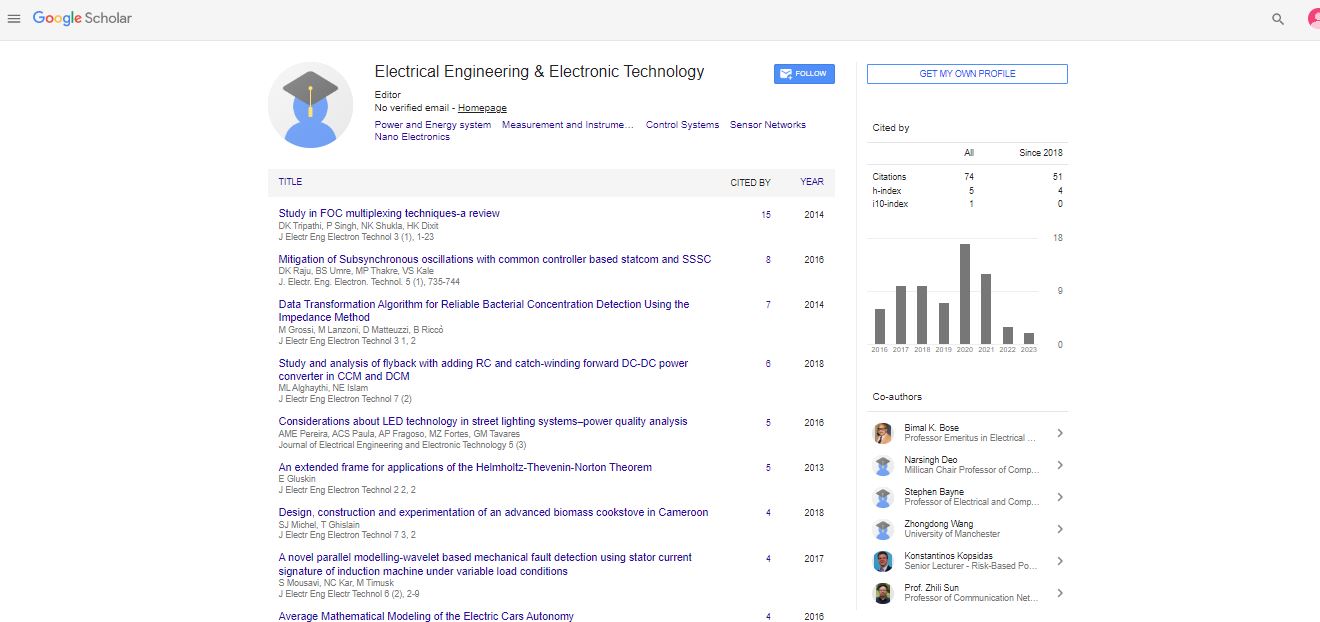Editorial, J Electr Eng Electron Technol Vol: 14 Issue: -1
Power Electronics: Revolutionizing Electrical Energy Control
Mohamed Rubeai*
Department of Microelectronics, University College Dublin, Ireland
- *Corresponding Author:
- Mohamed Rubeai
Department of Microelectronics, University College Dublin, Ireland
E-mail: Rubeai923@gmail.com
Received: 01-Jan-2025, Manuscript No. jeeet-25-170059; Editor assigned: 4-Jan-2025, Pre-QC No. jeeet-25-170059 (PQ); Reviewed: 18-Jan-2025, QC No. jeeet-25-170059; Revised: 25-Jan-2025, Manuscript No. jeeet-25-170059 (R); Published: 30-Jan-2025, DOI: 10.4172/2325-9838.1000990
Citation: Mohamed R (2025) Power Electronics: Revolutionizing Electrical Energy Control. J Electr Eng Electron Technol 14: 990
Introduction
Power electronics is a branch of electrical engineering that deals with the conversion, control, and conditioning of electrical power using semiconductor devices. It plays a critical role in modern electrical systems by enabling efficient and precise management of electrical energy. From renewable energy integration and electric vehicles to industrial automation and consumer electronics, power electronics is fundamental in shaping the way electrical power is used, controlled, and distributed in todayâ??s technology-driven world [1].
Discussion
At its core, power electronics involves electronic devices such as diodes, thyristors, transistors (like IGBTs and MOSFETs), and rectifiers to manipulate electrical power. Unlike conventional electromechanical switches, these semiconductor devices allow rapid switching, enabling the conversion of electrical power from one form to another with high efficiency and reliability [2].
One of the most common applications of power electronics is in power converters. These devices convert electrical energy between different forms: AC to DC (rectifiers), DC to AC (inverters), DC to DC (choppers), and AC to AC (cycloconverters). This versatility makes power electronics essential in many systems. For example, in renewable energy setups, solar panels generate DC power which is converted to AC using inverters before feeding the grid or powering homes. Similarly, in electric vehicles, power electronics manage the batteryâ??s DC power to drive AC motors efficiently [3].
Power electronics also enables motor control, which is vital in industries where precision speed and torque regulation are necessary. Variable frequency drives (VFDs) use power electronic converters to adjust the frequency and voltage supplied to AC motors, improving energy efficiency and process control.
Another significant aspect is power quality improvement. Power electronic devices such as active filters and static VAR compensators help mitigate harmonics, regulate voltage, and improve the overall stability of electrical systems. This is increasingly important with the proliferation of non-linear loads and distributed energy resources that can disrupt power grids [4].
The rapid advancement of semiconductor technology has propelled the power electronics field forward. Devices are now capable of handling higher voltages and currents, switching faster, and operating more efficiently, which reduces losses and improves system reliability. Additionally, advances in control algorithms and digital signal processors (DSPs) have enabled sophisticated, adaptive control of power electronic systems [5].
Despite these advantages, challenges remain. High switching frequencies can lead to electromagnetic interference (EMI), necessitating careful design and shielding. Thermal management is crucial, as power devices generate significant heat that must be dissipated to avoid failure.
Conclusion
Power electronics is an indispensable technology driving the efficient use and control of electrical energy in modern applications. Its ability to convert and regulate power with precision supports renewable energy integration, electric mobility, industrial automation, and power quality enhancement. As semiconductor devices continue to evolve, power electronics will become even more efficient, compact, and intelligent, paving the way for smarter and more sustainable electrical systems. Understanding power electronics is essential for engineers and professionals working toward a future powered by clean, reliable, and efficient energy.
References
- Grace S, Higgs J (2010). Integrative medicine: enhancing quality in primary health care. J Altern Complement Med. 16: 945â??950.
- Templeman K, Robinson A (2011). Integrative medicine models in contemporary primary health care. Complement Ther Med. 19: 84-92.
- Lake J, Helgason C, Sarris J (2012). Integrative mental health (IMH): paradigm, research, and clinical practice. The Journal of Science and Healing. 8: 50-57.
- Pengpid S, Peltzer K (2018). Utilization of traditional and complementary medicine in Indonesia: results of a national survey in 2014-15. Complement Ther Clin Pract. 33: 156-163.
- Stepleman LM, Penwell-Waines L, Valvano A (2015). Integrated care psychologists and their role in patient transition from medical to psychiatric specialty care settings: a conceptual model. Health Psychol Behav Med. 3: 154-168.
Indexed at, Google scholar, Cross ref
Indexed at, Google scholar, Cross ref
Indexed at, Google scholar, Cross ref
Indexed at, Google scholar, Cross ref
 Spanish
Spanish  Chinese
Chinese  Russian
Russian  German
German  French
French  Japanese
Japanese  Portuguese
Portuguese  Hindi
Hindi 
